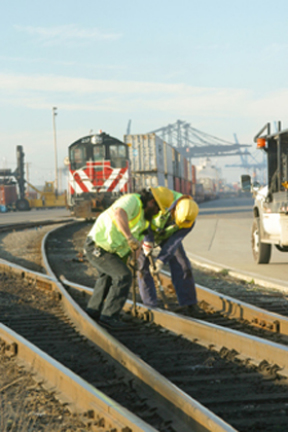With the rapid growth of trans-Pacific trade, the Port of Tacoma is working hard to stay ahead of the cargo rush by developing new terminals. In fact, the Port opened three new container terminals 2005. But thats only part of the story.
One of the Port’s top goals is being the most efficient and reliable intermodal gateway in North America. Over the last 20 years, the Port has made significant strides in building on its reputation as a leader in intermodal rail. A major focus of the Port’s Intermodal Transportation Line of Business is to build capacity and efficiency in the overall rail system.
Just a year ago, rail traffic was forecast to double in Tacoma by 2009. Today, says Jeannie Beckett, Senior Director of Intermodal Transportation, those predictions appear conservative.
The challenge: Develop a Portwide strategy — with the Port’s transportation business partners — to keep a step ahead of the demand for rail service. “The most important thing we can do is build upon the Port’s ‘three pillars’ for intermodal success — reliability, velocity and density of destination,” she said.
Laying more rail is also an important component of the Port’s plans. “We are in a continuous mode of planning and implementation for increased capacity and redundancy,” explained Robert Collins, the Port’s Director of Intermodal Services. “Between now and 2012, we will be constructing or expanding rail at every location touched by intermodal transportation on the Tideflats.”
Collins said the Port’s game plan for rail is, essentially, a three-pronged approach: improve operating efficiencies; build infrastructure improvements; and conduct long-term system planning.
Increasing the efficiency of intermodal cargo movement is the most cost-effective way to increase capacity with the existing rail infrastructure, says Beckett. To that end, the Port — in partnership with Tacoma Rail, Union Pacific and BNSF Railway — worked together to develop a joint command center, then accelerated the implementation of the center from 2006 to 2005. The Tacoma Command Center opened at the Port Business Center in May 2005.
The partnership determined early on that a common source of data was needed to base and measure daily Tideflats rail flow decisions. As a result, explained Collins, a web-based application — Business Exchange — was designed that all partners use to “see” into the supply chain. “This system is currently in the first phase of deployment, used by the partnership and by Intermodal terminal operators.”
The Port completed a 20-year strategic rail development study in March 2005. This study identified six projects that should be completed before 2008. Recognizing the importance of these priority projects, the Port of Tacoma Commission authorized the full design on the first two of those recommended projects — Bullfrog Junction and Chilcote Junction.
Bullfrog Junction is a critical intersection between the Tideflats and the two mainline railroads serving Tideflats customers. By adding track and reconfiguring the intersection, Collins explains that redundancy will be increased, improving safety and capacity. Rail from Washington United Terminals, Pierce County Terminal and Tacoma Rail all converge at Chilcote Junction, which runs beneath the SR-509 overpass on Port of Tacoma Road.
“Reconfiguring this area will increase redundancy and allow multiple trains to move to and from the terminals at the same time,” said Collins.
Both busy junctions will remain in full operation throughout construction, starting in early 2006 and anticipated to be completed in time for the busy 2006 pre-holiday shipping season. “We are working with mainline railroads and terminal operators to ensure that we’ve planned for everyone’s needs,” Collins said. “We all realize how important it is to work together on these projects.”
The Port and its consultants are now in the midst of five studies — four on existing facilities and a fifth, scheduled to begin soon, will take a big-picture look at the Port’s growth needs both on and off the Tideflats.
J. Michael Zachary, the Port’s Director of Port Planning and Logistics, is managing the planning studies for facilities on the Tideflats. Meanwhile, Collins is managing a study of the entire regional rail system.
According to Zachary, these studies will help the Port “identify what rail improvements can take place inside the Tideflats, adjacent to the Tideflats and outside the Tideflats . . . and what we need to do to meet our customers’ and potential customers’ current and future needs.”





